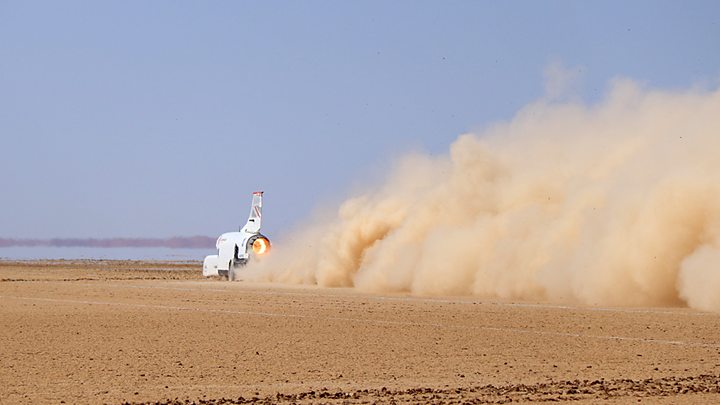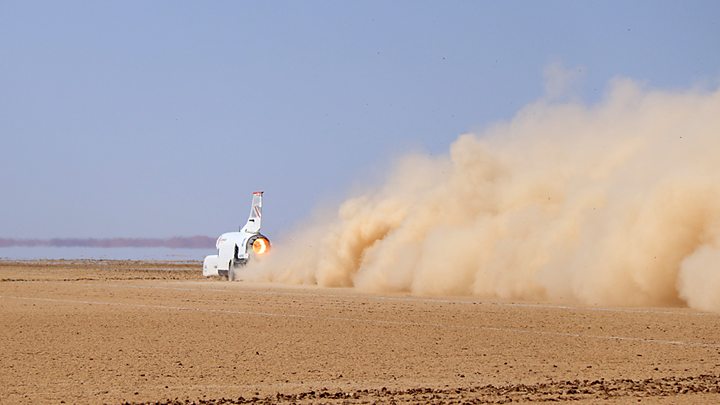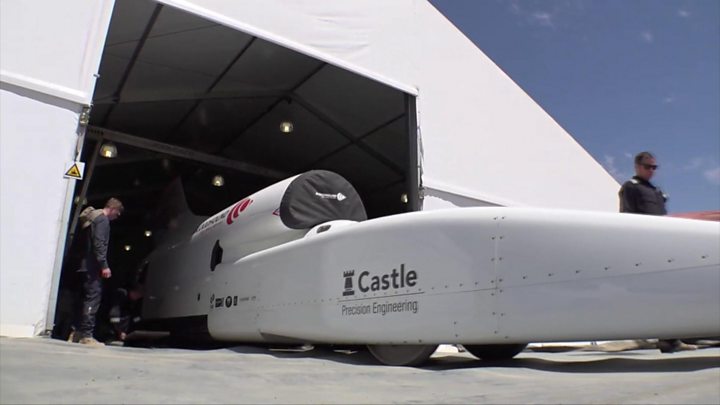Heat sensor frustrates Bloodhound land speed car
The British supercar cuts short its latest run because of temperature concerns but still clocks 481mph. …


Media playback is unsupported on your device
Engineers working on the new British challenge to the land speed record will spend the weekend chasing down a sensor issue on their Bloodhound car.
The arrow-shaped racer was targeting 550mph (885km/h) on Friday’s latest run across the Kalahari Desert, but driver Andy Green was forced to lift off the throttle early.
He’d received a cockpit warning that Bloodhound’s engine bay might be overheating.
The top speed was 481mph (774km/h).
That’s a little slower than the 501mph (806km/h) reached on Wednesday.
The “firewire” system had tripped on that occasion too, but it had occurred at the end of the run – not, as on Friday, at the fastest point along the 16km track.
Stuart Edmondson, Bloodhound’s head of engineering operations, said the problem could be like the “dodgy indicator” in a family saloon; the light comes on for no good reason. But in a land speed record car, such sensors can’t be ignored.
“We can’t keep losing runs because of this kind of thing, so we just have to bite the bullet and do a full examination of everything to do with that indication system,” he told BBC News.
This means taking the fin off Bloodhound, opening its upper chassis and removing the car’s Eurofighter-Typhoon jet engine.
The engineers can then take a close look at the sensor, which is essentially two parallel wires running though a plastic sheath. This wiring criss-crosses the engine bay.
When it gets too hot, the plastic melts and the two wires touch, triggering an alarm. It may simply be that a section of wiring has degraded or been crushed somehow.
If engineers can identify the cause and fix it in a timely fashion then it’s possible Bloodhound could be back out on its dry lakebed track on Monday morning.
Although it’s disappointing and frustrating not to see this six-tonne car go faster yet again, there’s an acceptance in the team that they’re on a learning curve.
Bloodhound is a one-of-a-kind – a prototype; and part of the road to a new world record above 763mph (1,228km/h) involves getting to know and understand all the car’s quirks.
Only then will the team be able to achieve the slick and repetitive operations needed to reach the very highest speeds.
Stuart Edmondson said: “When we come to do a land speed record, our opportunities to run will inevitably be limited by factors such as the weather and the wind, so we don’t want any unnecessary interruptions.
“And also not least because we’ll have the public here and there’ll be expectations.
“The firewire is bugging us and frustrating us and will only continue to do so unless we get in there and see what’s going on.”
Friday had started out with high expectations.
The wind, which can push the car offline, was light and blowing directly down the track.
The temperature was benign too at 24C and the Rolls-Royce Eurofighter engine develops its thrust much faster in cool conditions.
Andy Green planned to hold his foot to the floor for about 45 seconds, making a 550mph speed very attainable.
But when it was reported back over the radio that Bloodhound had come to a stop at the 9km marker and not the anticipated 11km point – it was obvious there’d been a hitch.
Andy Green was unperturbed by the firewire hassle, however. He lauded changes that had been made to the parachute brake to make it deploy smoothly on the run. And he’d got to test the limits of the steel wheel brakes at the end also.
“I’m braking as hard as I can; remember there’s no anti-lock braking on this car,” he explained.
“It’s all about how hard I can put the brakes on in an emergency. We’d been increasing it on previous runs and today we wanted to find the absolute limit. If I lock the wheels up, it will dig trenches in the track – but more importantly while the wheels are locked, they’re more prone to damage.”
The 90cm-diameter, 90kg, solid aluminium wheels have been one of the big successes out here. It was expected they’d suffer a much greater degree of scuffing and rutting. On the contrary, their surfaces are resisting the abrasion of the desert’s sand and grit exceptionally well.

Media playback is unsupported on your device
The current land speed record of 763mph (1,228km/h) was set in 1997, also by Wing Commander Green.
In doing so, he became the first person in history to take a wheeled vehicle beyond Mach 1, the speed of sound.
The speeds posted here by Bloodhound on Hakskeen Pan make it the third fastest British car of all time, behind Thrust2, which broke the land speed record in 1983; and Andy Green’s 1997 car, Thrust SSC.
The Bloodhound team would like to claim a speed in excess of 600mph (965km/h) before these trials end in a couple of weeks.
621mph would give a nice round 1,000 in km/h.
The idea is to come back to Hakskeen Pan in 12 or 18 months with a rocket fitted to the car in addition to its jet.
The extra five to six tonnes of thrust on top of the nine tonnes from the Eurofighter power plant could conceivably take Bloodhound beyond 800mph (1,290km/h).
Follow Jonathan on Twitter.


